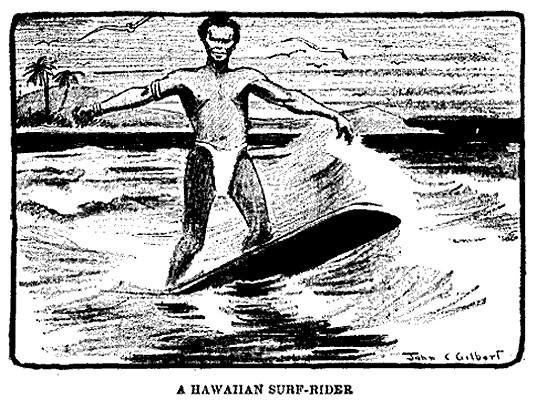 |
surfresearch.com.au
george : surfing in hawaii, 1900. |
| home | catalogue | history | references | appendix |
|
www.google.com.au/books

The surf-riders
would swim out to sea with these boards until they met a great wave.
They then threw
themselves upon the wave and were carried by it to the shore.
Page 50
The native is
a famous fisherman.
It would seem
almost impossible to us for human beings to become expert enough at swimming
and diving to be able to catch fish in the ocean without the use of hooks
or nets; yet the Hawaiian can do this.
He catches fish
with his hands.
Men, women and
children may often be seen engaged in this work.
Sometimes they
crouch in shallow water and feel around the coral and lava bottom for fish,
crabs and shrimps.
Many species of
fish in the Pacific Ocean hide themselves in clefts of the rocks and remain
there when danger seems near.
The fishers know
their hiding places, and search them, even in deep water. So skillfill
are they that even the swiftest fish have little chance of escape.
The men and boys
who catch the fish in deep water tie a bag around their waists and dive
straight to the bottom.
They hold fast
to a rock with one hand to steady themselves, and with the other feel about
in the crevices or under the overhanging rock ledges until they get hold
of a fish.
It is put into
the bag and the search for others is continued until they are obliged to
ascend for air.
The sea furnishes
not only food and employment, but the chief amusement - Surf-riding.
If the native
Hawaiian lives near the sea, hours of his time are spent in the water,
or about the wharves.
The rest of the day he spends in taro-planting, poi making, mat-weaving, reading, riding about, sleeping, playing his fiddle, or feasting.
|
Little Journeys to Hawaii and the Phillipine Islands. A. Flanagan Company, Chicago, New York, 1900 |

| home | catalogue | history | references | appendix |